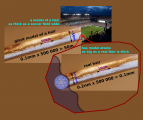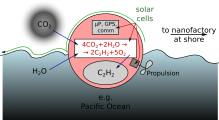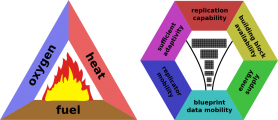Difference between revisions of "Mechadense's Wiki about Atomically Precise Manufacturing"
m (→The Goal - advanced Diamondoid Atomically Precise Manufacturing - Gemstone Metamaterial Technology: they -> parts) |
(→The Goal - advanced Diamondoid Atomically Precise Manufacturing - Gemstone Metamaterial Technology: improved readability) |
||
| Line 23: | Line 23: | ||
The products of this manufacturing method consist out of atomically precise [[diamondoid molecular elements|parts]]. These constituent parts like e.g. bearings gears springs and housing structures have the smallest possible physical size that allows for their functioning. When assembled the systems they create strikingly resemble conventional factory-equipment that one finds at the meter scale but on the meter scale those new kind of clearly non biological products may well be designed to be [[Intuitive_feel#The_feel_of_AP_Products|smooth elastic and seamless]] a trait only biological matter illustrates today. In contrast to atomic scale biological systems those artificial atomically precise systems do not rely on [//en.wikipedia.org/wiki/Brownian_motion thermal movement] for their function, instead they operate in the [[machine phase]]. Out of [[diamondoid|various reasons]] silicon, diamond and [[diamondoid|similar substances]] are suitable building materials. All of the [[diamondoid molecular elements|parts]] have their surfaces chemically plugged (passivated). Passivated surfaces do not bind to one another (not covalently to be exact). When the parts are aligned such that their atomic roughness can't intermesh they slide on each other [[superlubrication|wear free and superlubricating]].<br> | The products of this manufacturing method consist out of atomically precise [[diamondoid molecular elements|parts]]. These constituent parts like e.g. bearings gears springs and housing structures have the smallest possible physical size that allows for their functioning. When assembled the systems they create strikingly resemble conventional factory-equipment that one finds at the meter scale but on the meter scale those new kind of clearly non biological products may well be designed to be [[Intuitive_feel#The_feel_of_AP_Products|smooth elastic and seamless]] a trait only biological matter illustrates today. In contrast to atomic scale biological systems those artificial atomically precise systems do not rely on [//en.wikipedia.org/wiki/Brownian_motion thermal movement] for their function, instead they operate in the [[machine phase]]. Out of [[diamondoid|various reasons]] silicon, diamond and [[diamondoid|similar substances]] are suitable building materials. All of the [[diamondoid molecular elements|parts]] have their surfaces chemically plugged (passivated). Passivated surfaces do not bind to one another (not covalently to be exact). When the parts are aligned such that their atomic roughness can't intermesh they slide on each other [[superlubrication|wear free and superlubricating]].<br> | ||
| − | With [[exploratory engineering]] it was shown <ref name="nasy">[[Nanoystems|Nanosystems: Molecular Machinery, Manufacturing, and Computation - by K. Eric Drexler]]</ref> that [[ | + | With [[exploratory engineering]] it was shown <ref name="nasy">[[Nanoystems|Nanosystems: Molecular Machinery, Manufacturing, and Computation - by K. Eric Drexler]]</ref> that [[products of advanced atomically precise manufacturing]] will perform better than most products out of materials known today and due to the decentral (at home / locally) and direct (raw material to product in one step) characteristics of the manufacturing process there is also reason to assume that AP products will be cheap in production. Combined those properties may lead to drastic changes in human civilization over a short period of time giving us an [[opportunities|opportunity]] to rapidly solve yet untacklable global problems but also presenting us to new kinds of [[dangers]]. |
The technical details about the [[technology level III|targeted kind of technology]] can be found in the book Nanosystems <ref name="nasy"/>. It contains details about math physics and chemistry behind those machines. Among other things there is explained why quantum uncertainty is not really a problem, why thermal movement is a solvable challenge and why knowledge about natural solution phase chemistry is not directly applicable to chemical synthesis in the machine phase ([[mechanosynthesis]]). <br> | The technical details about the [[technology level III|targeted kind of technology]] can be found in the book Nanosystems <ref name="nasy"/>. It contains details about math physics and chemistry behind those machines. Among other things there is explained why quantum uncertainty is not really a problem, why thermal movement is a solvable challenge and why knowledge about natural solution phase chemistry is not directly applicable to chemical synthesis in the machine phase ([[mechanosynthesis]]). <br> | ||
Revision as of 12:45, 28 September 2015
| Language: en | Sprache: de |
- New: "what has been done up to one year back (max 100 entries)"
- Yet accumulated amount: all pages of this wiki - all images and files of this wiki
 A personal desktop gem-gum factory fabblet with dynamically deployed protective hood. |
The personal gem gum factory is:
The personal gem gum factory makes:
|
The existence of a personal fabricator will have profound impact on global human society. The basis for such a personal fabricator - the atomically precise manufacturing (APM) technology - is beginning to be figured out today.
|
Contents
What, Why, How, When
What is atomically precise manufacturing (APM)
The Goal - advanced Diamondoid Atomically Precise Manufacturing - Gemstone Metamaterial Technology
Advanced Atomically precise manufacturing (APM) is a prospective method of production for material goods of all sizes.
The products of this manufacturing method consist out of atomically precise parts. These constituent parts like e.g. bearings gears springs and housing structures have the smallest possible physical size that allows for their functioning. When assembled the systems they create strikingly resemble conventional factory-equipment that one finds at the meter scale but on the meter scale those new kind of clearly non biological products may well be designed to be smooth elastic and seamless a trait only biological matter illustrates today. In contrast to atomic scale biological systems those artificial atomically precise systems do not rely on thermal movement for their function, instead they operate in the machine phase. Out of various reasons silicon, diamond and similar substances are suitable building materials. All of the parts have their surfaces chemically plugged (passivated). Passivated surfaces do not bind to one another (not covalently to be exact). When the parts are aligned such that their atomic roughness can't intermesh they slide on each other wear free and superlubricating.
With exploratory engineering it was shown [1] that products of advanced atomically precise manufacturing will perform better than most products out of materials known today and due to the decentral (at home / locally) and direct (raw material to product in one step) characteristics of the manufacturing process there is also reason to assume that AP products will be cheap in production. Combined those properties may lead to drastic changes in human civilization over a short period of time giving us an opportunity to rapidly solve yet untacklable global problems but also presenting us to new kinds of dangers.
The technical details about the targeted kind of technology can be found in the book Nanosystems [1]. It contains details about math physics and chemistry behind those machines. Among other things there is explained why quantum uncertainty is not really a problem, why thermal movement is a solvable challenge and why knowledge about natural solution phase chemistry is not directly applicable to chemical synthesis in the machine phase (mechanosynthesis).
Atomically Precise Manufacturing in general
What also counts to atomically precise manufacturing are areas where less stiff structures are used:
- many processes in biological life (it is actually is the only kind of massively happening atomically precise manufacturing today)
- the early development phase towards diamondoid (gemstone-like) systems - (veering heavily away from the typical characteristics of life)
- excluded is thermodynamic crystal growth - the exact number of atoms and surfaces shapes can not be precisely controlled
Biological life is doing atomically precise manufacturing since it has emerged (albeit barely with atomic resolution). It provides direct examples for the feasibility for some things (floppy soft diffusion based systems out of chain molecules). It does not provide direct examples for the feasibility of the targeted things (stiff diamondoid diffusion suppressing systems out of crystolecule machine parts) but it at least gives a hint that it is maybe worth to investigate them. Doing so (with the means of exploratory engineering) unravels that there is potential far beyond the limits of biological systems. There are several reasons why evolution couldn't reach and will not reach this superior systems. There are pretty certainly no small evolutionary steps capable of shunning diffusion transport all together and directly moving into a practically perfect vacuum. But how can it be so different? The really good new technology usually learns from nature from the deeper lying more fundamental less intermingled aspects and not from the more superficial obvious aspects. This leads to quite different solutions as can be seen with e.g. the bicycle and the air-plane.
Why do we need APM?
The prospective products of AP technology are a chance to solve the global problems of human civilization and to preserve and further enrich our world. Further there are some essays about why you should care. Nonetheless public interest is declining (number of searches; newsgroup activity). Also in wide parts of the world the mere existence of APM is as good as unknow to the general public.
The reason for that development could be:
- The rapid increase of non atomically precise nanotechnology was drawing all attention away. See history.
- A lack of a place where the importance of AP Technology is explained, exciting but not so near motivational examples are given and at the same time grounded technical aspects are shown. (This site here could be such a place.)
How do we build a personal fabricator?
| Technology levels of the incremental path | |
|---|---|
| Level 0 | side products |
| Level I | side products |
| Level II | side products |
| Level III | pre-products products maybe |
There are two approaches:
- the direct path
- the incremental path
There is a some discussion about the perception of APM related work due to the people promoting the direct path - see: pathway controversy. This dates back to a dispute over the "ownership" over the very generic word "nanotechnology". This dispute led to a temporarily loss of publicly perceived credibility & funding of anything related to APM - see: history. Further the term atomically precise manufacturing way introduced by Eric Drexler to have a more specific name for the technology described on this wiki.
How long will it take us to get there?
The speed of progress in microcomputer technology shows that system complexity isn't so much of a hurdle. Finding the right steps through the initial path puts the greatest question-mark on the time-spans to expect. There's no such thing as a Moores law yet that we could track. Its not even sure if such a law may even occur and which metric would be used. Kilogram per second of monolithic atomically precise product maybe.
To be on the safe side we can assume that: (taken from a talk of Eric Drexler)
A) APM will come too soon to lean back and say "we don't need to think about the effects and the dangers that the arising APM technology will bring."
B) APM will come too late to lean back and say "we don't need to solve environmental problems because AP Technology will solve them."
Actually humanity puts quite some effort into research for improvement of current technology. So point B seems a bit pointless. Proponents of active APM research are sometimes accused of neglecting point B though which is not necessarily true.
Taking a completely arbitrary shot in the blue I (personal opinion of the sites admin) would hope that from the time of writing (2014) it will take not take more than somewhere between one and four generations (1G ~25a & 4G's ~ one long lifetime). Why? Because then I'll be able to see it ;).
What this site is for?
The aims of this wiki are:
- To gather information specifically relevant for the development of an advanced device for atomically precise manufacturing.
- To be comprehensible by average technological interested people but not at the expense of inaccuracy.
- To collect relevant TODO points.
In other words: To show that it's already rather clear what we have to do next.
In other words: To show that we already know which questions have to be investigated.
In other words: To show that by now there is enough knowledge for targeted development instead of aimless research. - To show that there is a lack of people working toward that goal today.
- To present this huge amount of fairly uncirculated knowledge in a for it suitable way. That is to gather all this information in a non-linear hyper-linked fashion - this wiki.
- To convey an intuitive feel for the mechanics of stiff AP nanomechanics.
- To explain the different aspects of the still far off but somewhat predictable advanced AP systems.
- To explain why the different aspects of advanced AP systems have a sound basis.
- To explain why the different aspects of advanced AP systems are potentially of high value.
- To discuss near and far dangers and opportunities that the emergence of near term and further out advanced AP products might bring.
- To gather general discussions about APM related topics like e.g. about general software issues.
Today (2014,2015) there is a puzzle of technological fragments. There are fragments of todays technology as well as fragments of future technology. Those fragments of future technology are to a certain degree credible since they are quite well accessible for theoretical investigation. The objective is to find and locate all the ends of the fragments that are located at the beginning of the time-line and to find out what work needs to be done to tie them together with the beginning of the fragments later in the time-line.
Contact / Contribution
Update: 2015-09-28 - The sites admin (I Lukas M. Süss aka mechadense) has decided to close the wiki for individual editing for now.
If you want to see something here that should be added or changed you can either contact me directly or discuss it with me on the sci-nanotech forum.
If you want to make backups or a fork of the whole thing please contact me. That would be great :) You can find the contact information on the about page.
If I do not hit the hosting service providers dead man's switch once a month this wiki will vanish! - Don't know how long I'll still be around.
Reasons for closing:
The amount the site has grown - even with a very good Sitemap documentation - newcomers would probably mess up this wikis structure by now.
The attainment of the knowledge about the fate of the wise-nano.com-wiki (see: Other sites)
- Pages where growing out of bounds since the concerns wherent seperated well. As a result things were repeated over and over again. That is precisely what a wiki should prevent from happening by providing hyper-linking.
- The topics where missing what really matters most - identifying the points where concrete investigations are needed. (well, to be fair that was not the focus of the wise-nano.com-wiki - "facts and implications" where)
- Also almost no illustrations where made - those are essential.
Old: Please read the guidelines on the community portal before contributing.
Note: When contributing here please avoid using the term nanotechnology and use more precise and specific terms (APM related terms) instead.
History has led to the fact that "nanotechnology" now (2013..2015) almost exclusively links to non atomically precise technologies or products of SciFi fantasy. The term "nanotechnology" is as specific as the term "makrotechnology" that is rarely used because of its generality.
External links
Locally hosted files
- Slides from the talk the apm-wiki site admin gave at the austrian "linuxwochen" event: slides-pdf-file
Webpages
- Foresight Institute: Nanotechnology
- Disquisition 2013 "Nano-solutions for the 21st century: Unleashing the fourth technological revolution"
- Zyvex's definition of APM
Videos
- Nanotechnologist Chris Phoenix on Molecular Manufacturing (2014-09?)
- Video of oxford talk (2014): Eric K. Drexler speaks about his new book "Radical Abundance"
- John Randall: "Atomically Precise Manufacturing" at Foresight Technical Conference 2013
Illuminating Atomic Precision: Foresight Technical Conference January 2013 - Fully Printed (2010-06) - Note: Diamondoid nanofactories will look and work differently and won't produce food.
- Ralph Merkle - An introduction to Molecular Nanotechnology (2009-11)
- presentation by Phillip Moriarty (2009-09):
SENS4 - Molecular Nanotechnology in the Real World: How Feasible is a Nanofactory?
(1/4) - (2/4) - (3/4) - (4/4) - Nottingham Nanotechnology debate (2005-08-24):
(1/7) - (2/7) - (3/7) - (4/7) - (5/7) - (6/7) - (7/7)
- BBC Horizon Nanoutopia (1995) - Note: The term "nanotechnology" turned out to be to unspecific and the assembler concept is now superseded by the nanofactory concept. The complexity of a nanofactory will be akin to modern day computer chips.




